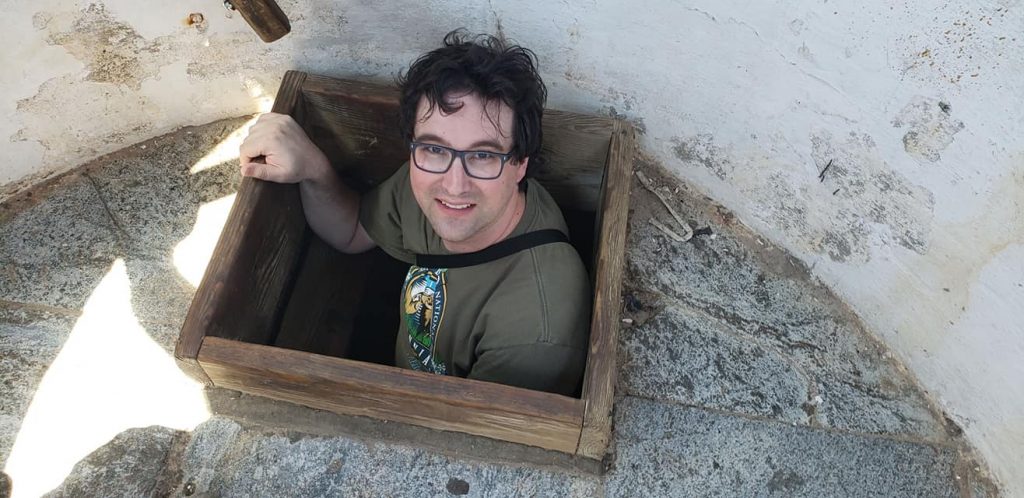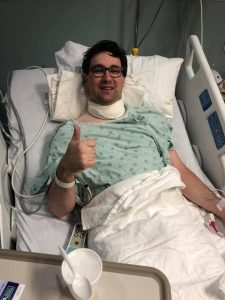Meet Scott Flanagan, a well-known quilter who has been living with adductor SD since January 2018. After receiving his initial diagnosis, Scott set to work to begin raising awareness about spasmodic dysphonia. Within a couple of months, he successfully raised $2,500 for the NSDA and discovered how to live and work with his new voice. Scott’s story is a positive reminder to keep pursuing your passions.

You’ve been diagnosed with SD for almost a year. Looking back, were there subtle changes in your voice beforehand?
I got my initial diagnosis in January of this year. However, in June of 2017 I noticed a change in my voice after we had finished with a big four-day Quilting Retreat with almost a hundred quilters at the shop where I work. The next day I woke up with my voice feeling very tired and I thought I had just overused it. From there, it got worse. My boss was concerned that I had laryngitis. Over the course of two weeks to the point where you would not be able to hear me over the phone. I literally had no voice. Finally, I went and saw my primary doctor for two to three minutes and then I got a prescription. I thought that I would feel better after a couple of days. Ten days went by and I was worse. I went and saw an ENT and he put me on permanent voice rest for a month. Unfortunately, that didn’t work. He then suggested that I see a voice specialist or a laryngologist, which is how I ended up at Dr. Bingcang’s office. At first, they thought it was muscle tension, so they gave me the option of trying botulinum toxin injections or speech therapy. I chose to try speech therapy first. But after two months I wasn’t getting anywhere so I tried the botulinum toxin injections. In December, we quit the speech therapy because it wasn’t working. I was finally diagnosed with SD.
What impact has SD had on your life?
In my job I do a lot of teaching both in the store as well as speaking nationally for quilt organizations. When I speak for groups like that, I speak to around 100-150 people at a time. I had to cancel this year’s schedule because lecturing for two hours is really exhausting. I still teach at work, but when I plan out my classes I am very strict with my time allotment and am very aware of how much I will be speaking each week. I use a sound system my company bought this for me so I don’t have to push to get volume or be heard.
I am very lucky to not only have support at work, but my family supports me too. I grew up in Colorado and my parents still live there now. Ever since my voice started having trouble a year ago, my parents have traveled to Nebraska for every single doctor’s appointment. So, we as a family are all going through this and I’m not solely going to the doctor’s office by myself.
With friends, if I get together and go out to dinner, they usually put me in the center of the group. I also bring a dry erase board if I know it will be loud. During dinner, I will just write notes and hold them up. It’s like Pictionary all the time.

How did you explain to your students at work that you were having challenges with your voice?
When my voice problems first began, I was scheduled to teach a class of twenty students. The person who could have filled in for me was not available so I ended up teaching a three-hour class without the ability to speak. Before class began, I wrote a note on the board that read, “I have a voice issue going on. I’ve been put on permanent voice rest for the next couple of weeks so we are going to play Pictionary as part of class.” The students were great about it.
Nowadays, during my classes, if I don’t have a dry erase board, I’ll set up a PowerPoint and do a live chat from my computer and type my answers on the screen. However, for the most part, the students know to listen carefully.
How did you get into quilting?
Ever since I was a little kid, I’ve had a passion for quilting. In college, I took a job at the quilt shop, where I work now, as a way to make a bit of extra money. It wasn’t meant to be a career. When it came close to graduation, they offered me a full time job. I thought about it for a while and finally accepted, figuring I could give it a year or two. That was 11 years ago.
In 2011, I decided I wanted to branch out more and started designing my own quilt patterns and freelancing with the two national magazines.
Do you have any advice for the newly diagnosed?
Since this started, I do Facebook posts for my family and friends. I keep a very open dialogue with what’s going on. I use it as an education opportunity. As for advice, I would suggest to let people know what’s going on and don’t be afraid to talk about it. Even in public, when I’m out for dinner and someone says, “oh, you’re sick.” I don’t just go along with it. I say, “I have a voice disorder, just bear with me.” If they ask questions, I write down on the back of my business card “dysphonia.org” so they can go online and do more research.
Scott Flanagan hosted and managed a fundraiser for the NSDA and raised awareness in the process.
Newly diagnosed, Scott thought to himself how can I help raise awareness for SD. He thought, “Okay, I am a well-known quilter, what can I do?” The owners, co-workers, and customers of the quilt shop, Country Traditions, rallied behind him and said, “We will do whatever we need to do to help.” With the support of his shop, Scott decided to host a fundraiser for the entire month of April. He set up a donation box at the quilt shop and requested that a $10 donation be made in order to receive one of Scott’s original quilt patterns. The average donation ended up being around $35. His goal was to raise $1,000 but he was blown away when they raised $2,500.

The quilt pattern (pictured) that Scott chose to donate was special, as he believed it spoke to the issue. He stated, “When I was trying to figure out what to do as my giveaway project, I was thinking about how geese use their voice to signal a change in the season (south in the winter, north in the summer). That spoke to me because when the SD started, almost a year ago now, my voice announced the season of change in my life. I thought, ‘What am I going to do? How can I use my voice to help others?’ In the end, I thought this pattern spoke to the situation I was going through.”
Scott has SLAD-R Surgery
Scott underwent SLAD-R Surgery in order to permanently impact his SD symptoms. Stay-tuned for more information about his journey.



